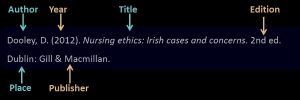Types Of Citation Styles and Examples: Citation also known as referencing, is the act of acknowledging the source of an academic work or idea by making reference to the original source thereby circumventing the academic wrong of plagiarism. The act of copying another’s idea, text or other creative work and having them presented as one’s own without permission or due acknowledgement of the original source is known as plagiarism. The demand for proper citation applies to both published and yet to be published sources.
In citing the source of ideas and information, citation must be properly done in compliance with the adopted referencing or citation style. What make up citation is the alphanumeric expressions originating from the details of the source.
Citation is very important in an academic research and writing for it extends the credit of an idea or work to whom it is due, and by providing the source of one’s idea or information, same is availed to the readers. Noncompliance with the requirement of citation in an academic work not only does it amount to plagiarism but forthwith reduces the authenticity of the research work to nothing. Proper citation is an attribute showing a well researched work.
Recommended: Characteristics of a good researcher
Citation Styles
Citation style is the set of rules laid down to be complied with while formatting the citation. There are different types of citation or referencing styles. A style to adopt depends on the requirement, field of the academic research or the institution.
Recommended: Countries with the Best Education System in the World
7 Main Types of Citation Styles With Examples
1. APA (AMERICAN PSYCHOLOGICAL ASSOCIATION): The APA referencing style is used mostly in education and social science field. The style is also used with or without modifications by several text, scientific and public health journals. The APA style employs in-text citations as well as parenthesis in referencing. It follows the pattern of author-date, thus, the name of the author comes first and then followed by the year of publication.

The style is in-text in the sense that the citation appears in-between the text. Further, either the whole or part of the source may be placed in parenthesis. Under this style, it is enough to refer to just the surname of the author which may or may not be followed by a comma (as the researcher so desires), and thereafter, followed by the year in which the author’s book so cited was published. Where it is a direct quotation, the page of the source so cited need to be included if it is such that is paginated.
Example of in-text APA citation:
a. Where the source has only one author: Okoro (1995) stated that cultural indifferences contributes to racial discrimination
Or
Cultural indifferences is a contributory factor to racial discrimination (Okoro, 1995)
b. Where the quotation is direct: cultural indifferences pose a justification for racial discrimination (Okoro, 1995, p. 10)
Example where the source has more than one author: Okoro and Johnson (1995) stated that cultural indifferences contributes to racial discrimination.
Or
Cultural indifferences is a contributory factor to racial discrimination (Okoro and Johnson, 1995)
c. Where the course cited is such that has two to five authors, all of the authors’ names are to be cited at the first citation. In the subsequent citation of the same source, it would be enough for the name of the first author to be written only, accompanied by ‘et al’. However, where the authors are up to six, all of their surnames should be listed in the reference section.
Also see: Differences Between Indemnity And Guarantee
d. Where the writer so cited has more than one work in a year, the citation should be distinguished with a lower case. Example. (Okoro, 1995a).
e. Where the source cited is gotten from a book as cited by another author, it should be cited thus for example: according to Nelson, cultural indifferences contribute to racial discrimination (as was cited in Okoro, 1995).
f. Where the source cited is an internet source, the year in which the information was published on that source is to be provided as well as the date the source (the website) was accessed.
Recommended: Why are Countries Referred to as Her or She? Answered
2. HARVARD CITATION STYLE: Harvard citation style was developed by Edward Laurens Mark, a Zoologist, who was formerly the director of Zoology Laboratory in Harvard. The style was therefore developed and first used in Harvard. It is similar to the APA style though with some differences. Harvard citation style is however used in scientific writing. Just like the APA style, it follows the author-date format, in-text citation and a reference list. Harvard style in addition includes the title of the source.

3. CHICAGO CITATION STYLE: Chicago citation style combines basically the humanities style and author-date. In addition and precision, it requires the title of the book, the month and date published, the publisher, city of publication, and in the case of online source, the date it was accessed and the web address.

Example of a Chicago citation style: Okoye, Paul.2007.”Theories of Reincarnation in the Early Traditional Doctrines”. Spain: Marks.
Example for an internet source: Okoye, Paul.2001. “Formidability of Natural Resources”. Accessed 27th April, 2012 http://www.educationjournal.edu/allacademics/.html
Recommended: Best Law Apps for Lawyers and Law Students
4. MLA (MODERN LANGUAGE ASSOCIATION): Hence the name, this citation style was developed by the Modern Language Association. It is mostly used in the field of arts and humanities, particularly in cultural studies, English and Literature studies. The MLA style used in-text citation and also provision of the list of cited works below the work.

MLA in-text citation follows the format of author’s last name followed by the page number in parenthesis. Where the book cited has more than two authors, ‘et al’ is used to represent the rest. Where the page numbers to be cited are not consecutive, they are to be separated by commas.
Where the pages are consecutive, they are to be identified using hyphen (as thus: 57-68).
Recommended: Advantages and Disadvantages of Weeds
5. CSE (COUNCIL OF SCIENCE EDITOR): This was formerly the council of Biology Editors (CBE) the citation is popularly used in the field of life and physical sciences. The in-text format comprise authors’ last name and the year of publication.

Example – in text: (Rollel and Kevun 1990).
For bibliographic: Rollel GH, Kevin H.O. 1990. Social Education and International Dispute Autonomy – 12/20
Recommended: Differences between active and passive learning
6. AMA CITATION STYLE: Hence the name, this style was developed by the American Medical Association. The style is known to medicine and health sciences.
AMA citation style in example:
For Books – John D. Education Development in Rural Areas. Chicago: Marks; 1997.
7. TURABIAN CITATION STYLE: The development of Turabian Citation is traceable to Kate Turabian in her work, “Manual for Writers if Research Papers and Term Papers”. The style is most similar to the Chicago citation style.
It is most applicable in the field of natural and social science.
Example:
For Books: John D. 1997.Education Development in Rural Areas. Chicago: Marks.
Recommended: Most Beautiful Countries in the World 2022
Conclusion
A good academic work is made up of 80% research and 20% writing. The background work done and the references made must therefore be evidenced via citation. Proper citation is a mark of quality academic research and output.
It is not a ceremonial or spontaneous requirement to cite sourced and referenced works; it is rather s demand which its non-compliance with amounts to the academic offence of plagiarism. The format and style regardless, the purpose of all the formats are the same. The differences sometimes are negligible, and each depends on the type of work being cited.

Edeh Samuel Chukwuemeka, ACMC, is a lawyer and a certified mediator/conciliator in Nigeria. He is also a developer with knowledge in various programming languages. Samuel is determined to leverage his skills in technology, SEO, and legal practice to revolutionize the legal profession worldwide by creating web and mobile applications that simplify legal research. Sam is also passionate about educating and providing valuable information to people.